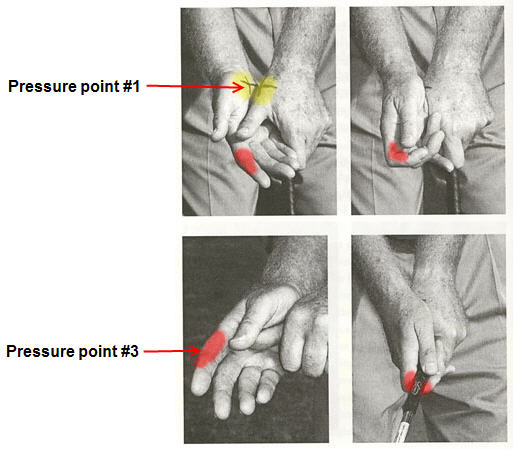There are 4 pressure points according to Mr. Kelley, with 3 of the 4 pressure points being in the hand. A golfer can use just one pressure point or any combination of pressure points, although 'hitters' and 'swingers' tend to use some of the pressure points over the other pressure points.
#1 PRESSURE POINT and PRESSURE POINT #3

I will go over the #1 and #3 pressure points together because this is the best picture I could find of either of them and they are often both used by golfers who use the 'hitter' pattern.
The #1 pressure point is the life line of the right hand, right where it either touches the left thumb or the clubshaft (depending on how you grip it). This is the primary 'thrust' pressure point for 'hitters.' If you want to thrust at the ball, do it with your #1 pressure point.
The #3 pressure point is the base joint of the right index finger. In this video, Mr. Hogan talks about this pressure point.
For the 'hitter', they can use the #3 Pressure point and the 'aiming point' concept. This concept has the golfer (in this case) find a spot in front of the ball (about 4 inches or so) and then aim the #3 pressure point at that spot in front of the ball. If they can do that, then they'll get a flat left wrist at impact with a impact motion of 'down, out, and forward.'
It is inadvisable for a 'swinger' to use only the #1 and #3 pressure points.
#2 PRESSURE POINT
The #2 Pressure Point is the last 3 fingers (pinky, ring and middle) of the left hand. This is a favored pressure point for golfers who use the 'swinger' pattern. Because the 'swinger' is pulling the club, this is one of the pressure points that enables them to do so and maintain the lag. The swinger's startdown is usually a 'rope pulling' motion. This is where the swinger gets at the top of the swing and feels like they are pulling a large rope straight down in order to 'ring the bell' one one of those old, large bells back in ancient times. But they 'ring the bell' with their left arm/left hand and this is a great pressure point to do it with.
Awhile ago I was back into 'swinging' and able to get a flat left wrist at impact and the key for me was to 'slam' that #2 pressure point right into ball (making sure to hit the ball first and then take a divot). Some will ask 'won't this cause a shank?' But I found that the hand will naturally turn over and square up the clubface.
#4 PRESSURE POINT
The #4 Pressure point is where the left arm and left side connect.
This is favored by 'swingers' as well. The 'swinger' will tend to keep their left arm connected to their left side throughout the downswing and just pivot so the clubhead will make connection with the golf ball.
As a 'swinger' I have used both the #4 and #2 pressure points, but never together. I would use 'left side' connection and then just pivot so the clubhead goes towards the ball. And as I mentioned with the #2 Pressure Point, I would pull the club straight down with that pressure point and then 'slam' it right at the ball.
As a 'hitter' I use the #3 Pressure Point to 'trace the plane line' on the way back and then thrust with the #1 Pressure Point on the way down.
REVIEW
1. Four Pressure Points, 3 of them in the hands.
2. Can use 1 or any combination of Pressure Points.
3. #1 and #3 PP's are favored by 'hitters', #2 and #4 PP's are favored by 'swingers.'
4. #1 PP is more of a 'thrusting' pressure point, #3 PP is more of a 'tracing' and 'aiming point' pressure point.
5. #2 PP is good for the 'swinger' start down. #4 PP is good for a 'pivot and let the hands take a ride' motion.
Up next, Power Accumulators.
3JACK
2 comments:
Great visual with "ringing the bell" from the top of the swing. Please note that some do better visualizing pulling the rope with the right arm rather than the left. Pulling the rope with the right arm is a good visual for Tom Tomasello's swinging procedure.
Tomasello used to pull both forearms down until the right arm connects back onto the body.
Post a Comment